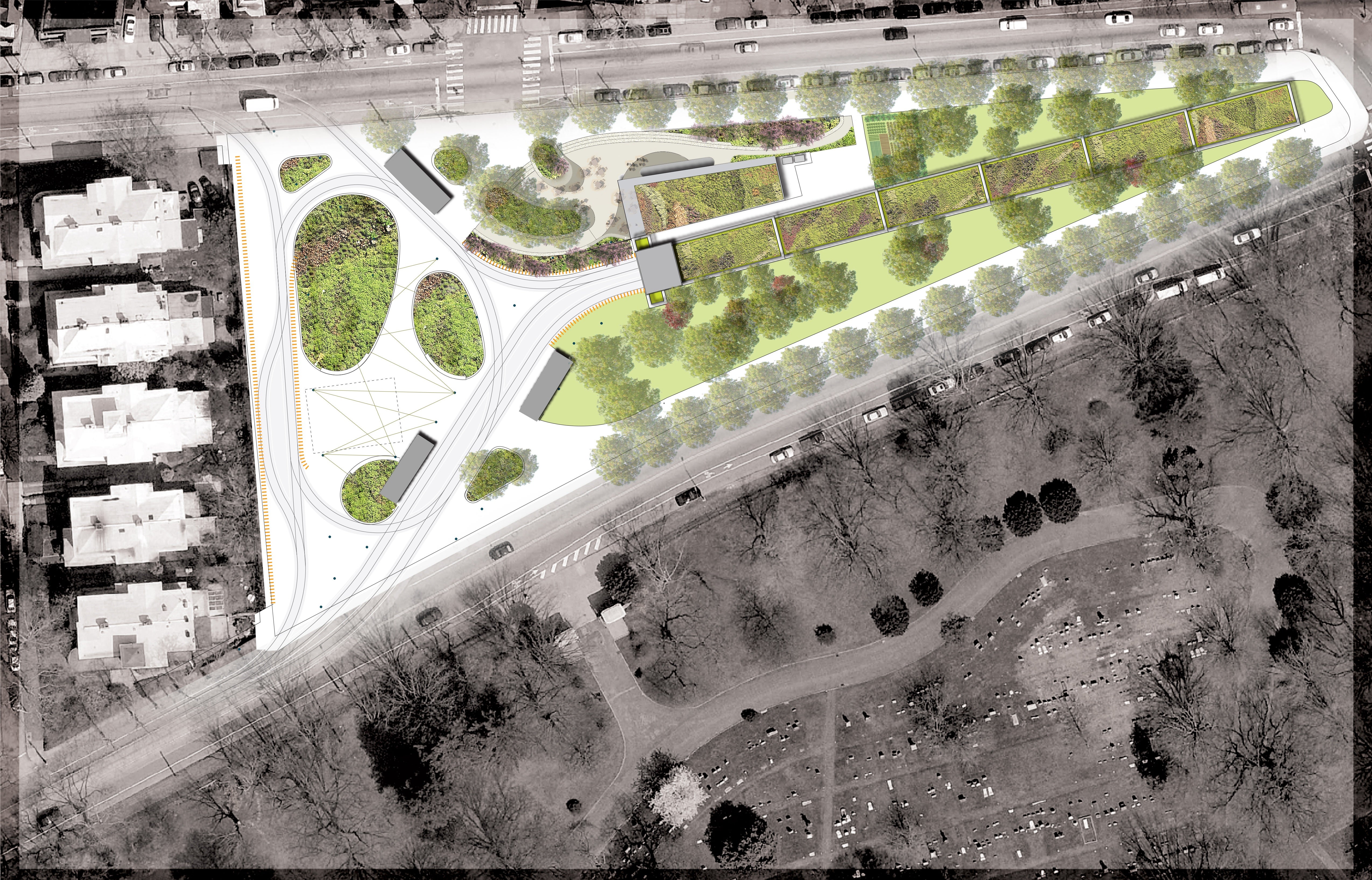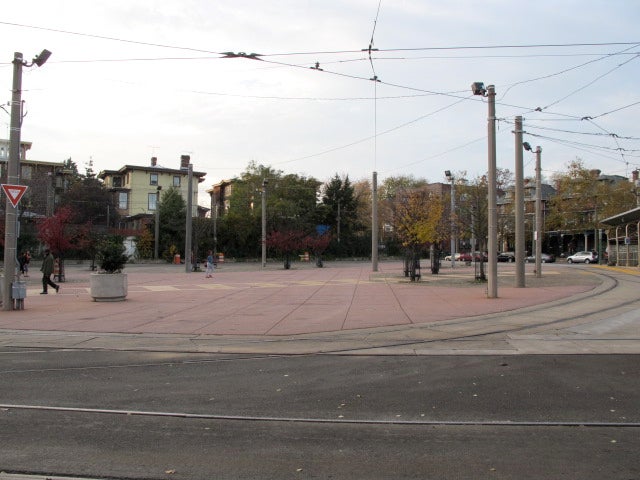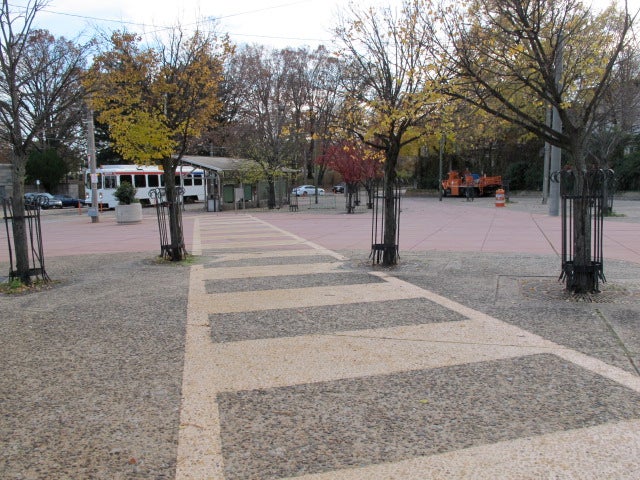University City District will make 40th Street Trolley Portal pedestrian friendly
Riding the 11, 13, 34 or 36 trolleys west from Center City, riders leave the darkness of the underground tunnel and, as their eyes adjust to the natural light, meet an open, barren field of concrete at the 40th Street Trolley Portal. Now University City District is working with SEPTA and city agencies to turn that bleak, gray space into an attractive, greened plaza that will serve as a more pedestrian and transit rider friendly gateway into University City and beyond.
UCD announced Tuesday that it has collaborated with landscape architects at Andropogon Associates, SEPTA and city agencies to develop a preliminary plan to revamp and commercialize the 40th Street Trolley Portal beginning sometime in 2013.
Though flexible, the plan currently calls for a two-phase overhaul. The first phase will improve pedestrian safety, add vegetation and build storm water infrastructure. The second phase will build a café or some type of commercial space.
If there are 1,000 steps to complete the project, UCD Executive Director Matt Bergheiser said, UCD, SEPTA and the City have taken about 100, but they are an important 100 he told the Spruce Hill Community Association at its board meeting Tuesday night.
Second times a charm
Years ago, a plan was developed to spruce up the 40th Street Trolley Portal but it stalled and fizzled.
“The plan [developed], then sat on the shelf and nothing happened with it,” said Barry Grossbach, chair of the SHCA zoning committee. “The thing was we didn’t have the key players at the table.”
Though this current attempt is still in an early phase of development, Bergheiser said he feels “really good about it.” He attributed a big part of that to the fact that SEPTA and the City have been willing to collaborate and work together.
“I think people at all levels are thinking very progressively,” Bergheiser said. “…I think it’s just a matter of a bunch of people at the table who want to see this happen but who have very real logistical issues.”
Despite the fact that 900 steps remain and include logistical issues, Bergheiser said the hurdles that remain for the City and SEPTA are very reasonable hurdles.
Pedestrian safety
The primary goal of the project is to improve pedestrian safety, since the Portal sits near 40th Street, Woodland Avenue and Baltimore Avenue.
According to UCD’s Seth Budick, the portal had an average of 3,377 average daily riders in 2010, making it the second busiest trolley-only stop in University City. UCD estimates that at lunchtime approximately 500 pedestrian trips are made to, from or adjacent to the portal, and in the evening about 900 such trips are made.
“There’s many, many conflicts with pedestrians and trolleys, which is a very real concern, mainly because there’s not many places where people are directed,” said Nate Hommel, capital projects manager at UCD.
To improve pedestrian safety, UCD will build three raised mounds in the “apron,” the curved, oval space between the trolley tracks. These mounds will be a few feet tall at the crest and will slope gradually downward.
The mounds will guide pedestrians through the space but not give rigid directions like the current painted pedestrian path that exists now and which few people walking through the space actually follow.
Instead of telling people where to walk, the mounds will guide people through the space, Hommel said.
“It’s a subtle way of telling people where they really shouldn’t be walking,” he said.
Greening the space
“Really we’re trying to re-vegetate as much as possible and make that landscape a working landscape,” Hommell said.
The current apron is approximately 16,000 square feet. The mounds will be filled with native, seasonal plants and will add 7,000 square feet of green space – cutting the amount of impervious, concrete surface by nearly half.
“I think this is a great idea,” said David Horwitz, a SHCA member who has lived in the area for 71 years. “What’s to be said for barren concrete?”
In addition to the apron, greenery will be added to the rest of the 40th Street Trolley Portal plaza. The portal’s roof, which was replaced in 2008, will be transformed into a green roof, and trees, which cannot be planted in the apron because of overhead catenary wires, will likely be planted around the commercial space.
All of these elements will add to the portal’s stormwater management potential and earn SEPTA a financial incentive from the Philadelphia Water Department.
As an added benefit, the water collected through the storm water infrastructure will be used as graywater to irrigate the vegetation in the plaza.
Horwitz said he believes part of SEPTA’s willingness to collaborate on the project this time around is due to the authority’s interest in stormwater management – an interest that was not as strong, or financially incentivized, when the first plan was developed.
“It’s not selfish of them,” Horwitz said. “They can be good citizens and save money too.”
The big question
It is too early in the process to give exact cost estimates, but Bergheiser said phase one could cost a little more than one million dollars. Phase two, the commercial element, might cost a little more than phase one, and together the project might cost around $3 million.
Though most of the funding is up in the air, UCD has committed $650,000 for phase one.
“That won’t get us even to a complete phase one, but we think it’s a very significant step moving forward,” Bergheiser said.
This is one of the first times UCD has committed money to a project in this way, but Bergheiser said UCD’s roll has been evolving, that the organization has run surplus budgets for the past few years and that it has been squirreling money away for a project that met the goals of both the neighborhood and UCD. Bergheiser said this is the project.
As part of UCD’s expanding capacity, the organization will be responsible for maintenance of the plaza and will factor necessary upkeep costs into its annual budget going forward.
“Obviously this doesn’t benefit anybody if you put this out there and then run away from it,” Hommel said.
Café and programming
The café or businesses that will eventually come to the space will generate some minimal revenue for maintenance costs through a rent structure that UCD will work out.
Because this is public property, an RFP will be sent out for business proposals.
“They keep using the word café,” Horwitz said. “How about the word diner?”
While there may be programming incorporated into the space, Bergheiser said, “To be frank, it’d be quite a bit less so than The Porch [at 30th Street]. It’s a fundamentally different space.”
Though the portal is fundamentally different than The Porch, Tom Lussenhop, a SHCA member who lives locally, said those interested in the portal project should take comfort in UCD’s success with The Porch.
“It’s very exciting to see this come to reality,” Lussenhop said. “I only have one complaint and that is it’s not going to happen overnight.”
Bergheiser said UCD hopes to start phase one of the project in calendar year 2013. Until then, UCD will continue to share its plans with more of the community and is open to feedback.
Contact the reporter at cfisher@planphilly.com
WHYY is your source for fact-based, in-depth journalism and information. As a nonprofit organization, we rely on financial support from readers like you. Please give today.






